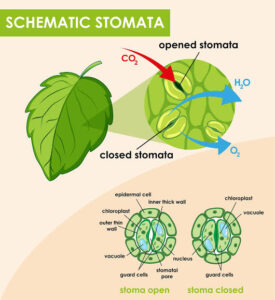Back to: Botany 400 Level
My ever-smart Afrilearn superstar! How you dey today? I’m really happy we’re learning together again — you always show up ready to grow, and that’s something to be proud of! Today, we’re going into something small but mighty inside plant leaves — the role of guard cells in stomatal opening and closing. These tiny cells may be small like beans, but they play a very big role in helping plants breathe, stay cool, and survive. Let’s gist about how they work in a way you go relate with well-well!
Role of guard cells in stomatal opening and closing
You see those small openings on leaves, like tiny mouths? Those are called stomata (singular: stoma). But the real magicians behind their opening and closing are called guard cells. Think of them like security men wey dey control the door — opening it when it’s safe and needed, and locking it when things no balance. Without these guard cells, plants go struggle to take in carbon dioxide, release oxygen, or even control how much water they lose.

How Guard Cells Work
Each stoma is surrounded by two guard cells shaped like curved sausages. These cells control whether the pore (the stoma) opens or stays closed. They are smart and respond to the plant’s needs and environmental conditions.
When Stomata Open
This usually happens during the day when there is light and photosynthesis is active.

Guard cells absorb water through osmosis, become turgid (swollen), and curve away from each other.
This opens the stomatal pore, allowing carbon dioxide to enter for photosynthesis and oxygen to leave.
When Stomata Close
This happens at night or when the plant is under stress (e.g. too hot, too dry).
Guard cells lose water, become flaccid (shrink), and collapse towards each other, closing the pore.
This helps the plant reduce water loss through transpiration.
What Controls the Guard Cells?
Guard cells don’t act anyhow — they respond to many signals:
Light: Blue light especially triggers potassium ions to enter guard cells, causing water to follow.

Water availability: If water is scarce, the guard cells won’t take in water — meaning the stomata stays closed.
Carbon dioxide levels: If CO₂ inside is high, guard cells may close the stomata to save water.
Plant hormones: For example, abscisic acid (ABA) helps close stomata during drought stress.
Let’s say you have a pawpaw plant in your compound. In the morning, the guard cells in its leaves absorb water, swell up and open the stomata. This allows carbon dioxide to enter, and the plant starts making food. But by 2pm, when the sun don dey hot and water dey scarce, the same guard cells shrink and close the stomata to protect the plant from too much water loss. Just like your mum go close the windows when rain dey beat hard — smart and protective!
Summary
Guard cells are special cells that control the opening and closing of stomata on plant leaves.
They open when they take in water and become turgid; they close when they lose water and become flaccid.
This helps regulate gas exchange (CO₂ in, O₂ out) and water loss (transpiration).
Light, water, carbon dioxide, and hormones influence their actions.
Evaluation
- What is the main function of guard cells?
- Describe what happens to guard cells when there is plenty of water.
- Why is it important for stomata to close during dry conditions?
- Name one hormone that helps guard cells close stomata.
You just learned something very powerful about how plants survive tough conditions and still produce food. Remember, you’re growing strong just like these plants — with the right knowledge, your mind go flourish! Keep learning with Afrilearn, where every lesson is for your greatness. See you in the next class, and keep shining like the star you are!
